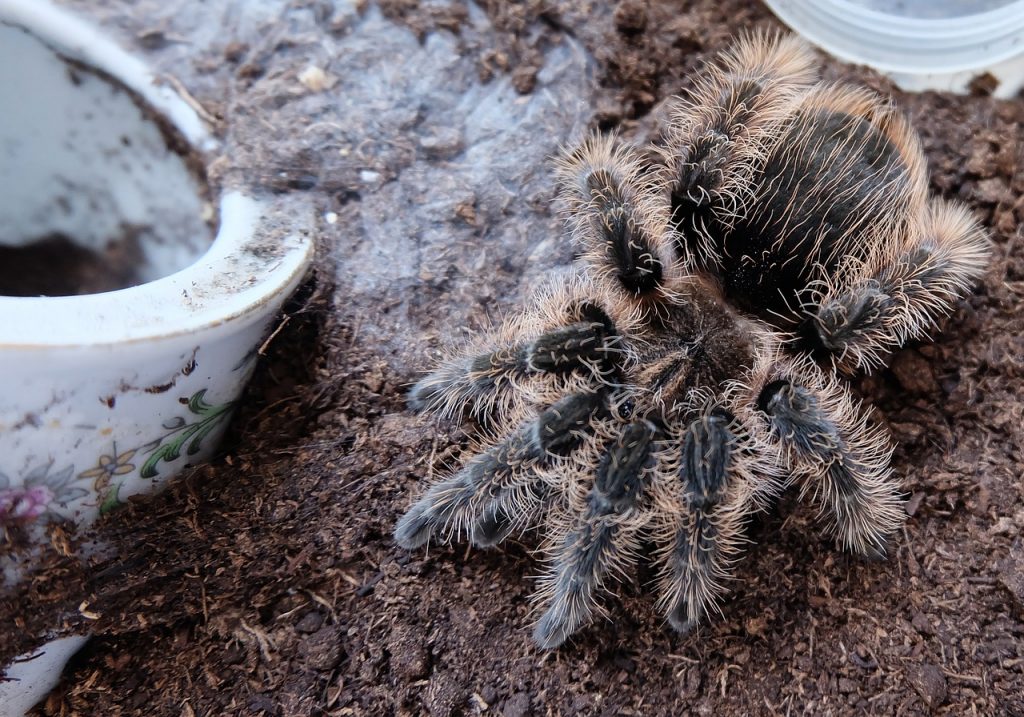One of the most pressing questions for new spider keepers is whether their tarantula is molting or dead. Fortunately, it is generally pretty easy to tell the difference when you know what you’re looking for.
At the time of writing my own personal tarantula collection consists of over 250 specimens, so I get molts pretty much every day of the year. Based on that experience, here’s how to tell if a tarantula is molting or dead…
Signs a Tarantula is Molting
There are numerous signs that a tarantula is molting. Some are more common than others, but put together you should be able to get a decent idea of whether your spider is attempting to molt or has died.
My Tarantula is Upside Down
Possibly the most reliable sign a tarantula is molting is that it is lying upside down. That is to say – with it’s legs in the air. While a handful of tarantulas will molt standing up normally, the majority will flip over onto their back, and over a number of hours you’ll see the old skin slowly being pushed off.
It goes without saying that if it looks like there are two tarantulas in the cage then the second one is almost-certainly a sloughed skin and your tarantula has molted recently.
My Tarantula Has Spun a Thick Web
Many tarantulas spin a fresh web to molt on. This helps to protect them from predators or parasites during this most-sensitive of times.
A ground-dwelling tarantula may build an attractive sheet of web to molt on. An arboreal tarantula or one with a burrow may block up the entrance to their hide with thick webbing.
Whatever the case, the sudden appearance of lots more web than normal may well be an indication of a molt drawing close.

My Tarantula Has Been Hiding Away for Ages
Tarantulas tend to stop eating some weeks before they’re going to molt. This “premolt” phase may even last for months in some species. If you’ve noticed that your tarantula has gone off its food, then has gone to hide away then this too may be a symptom of an upcoming molt.
Of course, there is also a risk that a lack of appetite may reflect an old or sick tarantula, so this factor alone doesn’t necessarily guarantee a molt.
My Tarantula’s Abdomen Has Gone Darker Recently
Tarantulas from the Americas that kick off their hairs as a defense often end up with a “bald patch” on their abdomen. When nearing a molt, this bald patch will darken as the new skin forms below it.
In some species this will turn a glossy black just a week or two before the molt itself.
If you’ve noticed the abdomen of your tarantula turn very dark recently then it’s likely they’re coming up the molt.
My Tarantula Looks Pale
When a tarantula molts it takes some time for the new skin to harden up. During this period your tarantula will refuse food, and may be seen doing strange, yoga-like stretching exercises to expand the new skin.
A very freshly molted tarantula – literally within the last 24-48 hours – generally appears quite a bit paler than they normally do. The fangs may be white in color, rather than black, while colors may look brighter and more vivid in general.
A very pale tarantula has almost certainly molted recently.
My Records Suggest It
As a tarantula keeper it’s well worth keeping records of when your tarantula molts. Jot it down on your phone or write it on a sticker on the cage. Over time you’ll find that your tarantula falls into a pattern. When you know the dates of the last 3 or 4 molts your tarantula had, it becomes far easier to predict when the next molt is likely to happen.
Signs a Tarantula is Dead
First – the bad news. Just because a tarantula is coming up to molt doesn’t mean it won’t die. Indeed, it could be argued your tarantula is more likely to die from a molt than almost anything else.
All the same, here are some signs that your tarantula could be dead rather than molting…
My Tarantula is the Right Way Up
If your tarantula is the right way up, yet seems lethargic or lifeless then it may well be dead or dying. If you’re in any doubt, however, don’t start planning a funeral for your pet just yet. It could be, for example, that your tarantula is preparing for a molt and soon enough will flip over onto its back.
My Tarantulas Legs Look Wrong
A tarantula that is holding its legs in an unusual way may be in trouble. There are two things in particular to look out for.
Firstly, some tarantulas suffer from a condition known as “DKS” where they lose full control over their legs. Their movement becomes “juddery” and they may struggle to move around and catch prey items. If your tarantula has been struggling to walk normally recently then this could be a sign of DKS setting in. The eventual conclusion is often quite bad.
A second option is your tarantula’s legs are curled underneath their body. A tarantula that is the right way up, but whose legs are curled up under their body, is likely to be at or close to death.
However this same sign is seen in dehydrated tarantulas. This is because tarantulas need fluid in their body to extend their legs. As moisture levels decrease, they lose the ability to fully extend their legs. Any tarantula observed in this manner should be immediately offered a drink of water in the hope that this remedies the situation.
The post Tarantula Molting Or Dead? appeared first on Keeping Exotic Pets.
-----------------------------------------------------------------------------------------------------------------
By: Richard Adams
Title: Tarantula Molting Or Dead?
Sourced From: www.keepingexoticpets.com/tarantula-molting-or-dead/
Published Date: Sun, 06 Feb 2022 11:00:17 +0000






